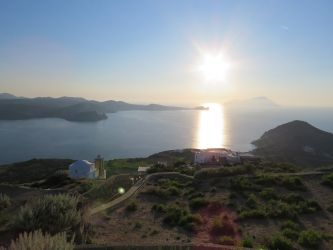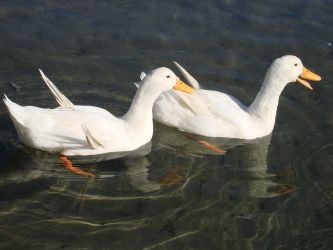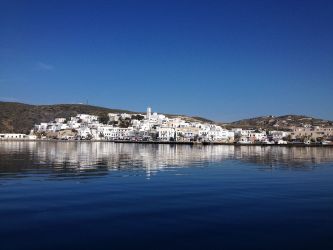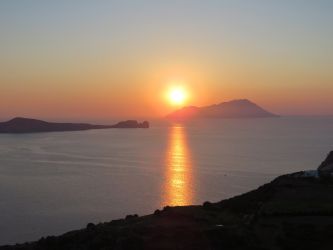Situated on the beautiful Cycladic island of Milos, Milos Crafts Design Studio has embraced the ‘slow made’ philosophy of quality over quantity, and is dedicated to producing everything locally and responsibly on the island. The studio is multidisciplinary and focuses on using skilled artisan techniques in combination with traditional, innovative, and sustainable materials to create high-quality products, unique to Milos. In keeping with the ‘slow made’ philosophy, craft workshops are an integral part of the studio’s practice, offering an insight into the whole creative process, from design and production to possible reuse. In this way, the studio hopes to spread its passion for the ‘beautifully made’ by promoting and transmitting craft skills and knowledge to others, as well as enhancing and expanding professional competences in the applied arts & crafts.
The Milos Crafts Philosophy
Slow Made, quality and durability over quantity.
The studio has embraced the ‘slow made’ philosophy which means products are reasonably priced and locally produced using ‘green design’ methods and artisan construction techniques. An important aspect of the ‘slow made’ philosophy is ‘collaborative design’ where customer’s join in the design and creation of their own product, whether for personal or professional use, as well as craft workshops and studio open days.
The studio focuses on the following values:
- Thoughtfully creating unique, durable products
- Producing locally using sustainable and environmentally-friendly materials and construction methods
- Exploring the use of local and traditional materials and artisan techniques
- Making art and craft accessible to all
- Promoting art and craft as a form of self-expression and “art self-therapy”
Did you know that arts and crafts are good for you?
Research shows that ‘creative expression’ has a powerful impact on health and well-being and is now considered a wellness practice. Read more about this here.
About the Artist
Julie has been travelling between Milos and Ireland for the last 30 years, and she has adopted artistic creation as a way of life and a means through which to explore the history and culture of both localles. She grew up in a creative family in Ireland, learning myths, legends and folktales from her grandmother while learning drawing, painting and fabric printing from her mother who worked as a textile designer in the linen industry. It was from her mother that she learnt about Henri Matisse, and how his famous linen wall hangings ‘Oceanie – La Mer’ and ‘Oceanie – Le Ciel’ (more information here) were screen printed in Belfast (1946), and also about the two great textile artists, Barron and Larcher (who mentored Susan Bosence).
She received a BA (Hons) in Three Dimensional Design from the University of Ulster, Belfast, Northern Ireland, where she developed an interest in integrating the human body with sculpture, developing jewellery ranges using gold, platinum, diamonds, titanium, stainless steel and aluminium. Parallel to her studies she worked as a costume and set designer in amateur theatre, and volunteered in schools for “differently abled” children (having lots of fun) making costumes for wheelchair bound children and children with prosthetics.
She moved to Greece where she raised her family and continued her artistic interests, in particular batik, lino printing and fabric printing, as well as learning local heritage skills such as traditional embroidery, cut work (see here for more information) and lace making. An elderly lady showed her how to cut up old plastic bags into long lengths which could be made into floor mats using weaving or crochet, an early introduction to up-cycling.
She has since expanded her knowledge and skills by completing courses in Ecological Silkscreen printing (Edinburgh Printmakers Studio, Scotland), Accessory Design and Manufacture, and Leather Bag Design and Manufacture (London College of Fashion, Cordwainers), as well as learning traditional espadrille making techniques with a Greek Master Craftsman in Athens.
In her free time Julie records and illustrates local stories, narratives and myths as well as her own experiences, and studies the unique nature and environment of Milos, using these as a rich source of inspiration. She also spends much time in museums and galleries, locally and internationally, drawing inspiration from traditional craft techniques around the world.
Julie’s current long term project is establishing a dye garden and researching the sustainable use of the flora and fauna of the island to make natural pigments and dyes.
Milos Crafts Design Studio Facilities
The Milos Crafts Studio is in Neohori, on Milos Island, Greece. It is 5 minutes from the port of Adamas, in a quiet residential area, and easy to reach on foot, by car or public transport. There is free on-site parking.
The Studio offers a friendly, creative environment and maker’s space with a range of specialist machinery and equipment.
- Fashion Design and Sewing
The equipment in the sewing area includes both industrial sewing machines and domestic machines.
Adjustable adult and child dressmaker’s mannequins, for accurate construction and sewing of fashion garments
A wide range of types and colours of threads – for a wide range of materials and purposes including “Free Motion Machine Embroidery”
- Leather Crafting
Adler – cylinder arm sewing machine for precision sewing of leather, thick canvas, vinyl, synthetics and webbing for bags, sandals, belts, wallets, light luggage, bespoke upholstery, etc.
Fortuna Skiving machine – specialised for the making of leather goods by reducing the thickness of leather.
- Embossing, silver gold/foiling & book binding.
Impress Hm4 Hot Foil Printing Machine Press
One of the few such machines in Greece, this is a vintage manual printing press. It has a four ton pressure and is used for leather embossing/debossing and silver/gold foiling onto materials such as leather, wood, vinyl, plastic, paper and card. Although it’s a very heavy professional machine it’s surprisingly easy to use, with either dies or old fashioned movable type. The type was made by a very elderly gent who was one of the last two engravers of brass type in England. Using it is a unique experience that carries you back in time.
- Screen Printing
Vacuum table, drying rack, frames and squeegees, pigments and inks
- Design
Wacom Cintiq 22HD drawing tablet.
Light table/Lightbox
- The Library
The studio has a small library which is open to the public. The collection is a great source for reference or for when creativity needs something to play with. This service is freely available to everyone but please note, we do not lend out books.
This slideshow requires JavaScript.





